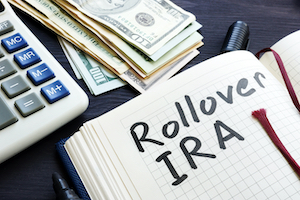While traditional and Roth IRAs play a key role in household balance sheets, representing 36% of household financial assets among those owning them, new research also reveals that rollover activity, which helps many Americans preserve their retirement savings, has fueled recent individual retirement account (IRA) growth.
 In fact, the Investment Company Institute’s latest research shows that traditional IRA–owning households were more likely to have engaged in rollover activity.
In fact, the Investment Company Institute’s latest research shows that traditional IRA–owning households were more likely to have engaged in rollover activity.
In mid-2023, 55.5 million U.S. households, or slightly more than 42%, reported that they owned IRAs. However, about 25 million U.S. households—or 62% of U.S. households owning traditional IRAs—had traditional IRAs that included rollover assets.
To help put that into perspective, the most recent data available shows that households transferred $595 billion from employer-sponsored (DC or DB or both) retirement plans to traditional IRAs in 2020. All told, more than 7 in 10 U.S. households had retirement plans through work or IRAs; and being later in the life cycle of saving, more than 8 in 10 near-retiree households did.
Among traditional IRA–owning households with rollovers, 86% indicated that they had preserved their entire employer-sponsored retirement plan balance in their most recent rollover.
Moreover, about 6 in 10 traditional IRA–owning households with rollovers made their most recent rollover in 2018 or later, including 31% whose most recent rollover was in 2020 or later. Notably, among households with rollovers in their traditional IRAs, only about 43% percent had made traditional IRA contributions in addition to their rollovers.
Reasons for Rollovers
And while most traditional IRA–owning households with rollovers had multiple reasons for rolling over the balances from their employer-sponsored plans to traditional IRAs, the three most common primary reasons for doing so were:
- not wanting to leave assets behind at the former employer (22%);
- wanting to consolidate assets (21%); and
- wanting more investment options (17%).
Interestingly, 66% of respondents said a reason for their most recent rollover was that they did not want to leave assets with their former employer. What’s more, 43% of traditional IRA–owning households with rollovers indicated that they wanted to keep their assets with the same financial services provider when they rolled over assets. In contrast, 41% said they rolled over to change financial services providers.
Sources of Information
When asked about their decision to roll over, traditional IRA–owning households indicated that they generally researched the decision to roll money over from their former employer’s retirement plan into a traditional IRA. In this case, 63% consulted multiple sources of information—the most common source of information was professional financial advisers, who were consulted by 63% of traditional IRA–owning households with rollovers, ICI notes.
Additionally, 34% of traditional IRA–owning households with rollovers relied on information provided by their employers, with 26% using printed materials from their employers as a source of information and 20% consulting online materials from their employers. Another 30% said they were told by a financial adviser to roll over, and 27% thought it was easier to roll over to an IRA than into their new employer’s plan.
When asked to identify their primary source of information on the rollover decision, 50% of traditional IRA–owning households with rollovers primarily relied on professional financial advisers. Older households, not surprisingly, were more likely to consult professional financial advisers than younger households.
In this case, 18% of traditional IRA–owning households with rollovers identified their primary source of information on the rollover decision as financial services firms. Seven percent of traditional IRA–owning households with rollovers said their primary source of information was online materials from these firms, with younger households more likely to rely primarily on online resources than older households.
Notably, most traditional IRA–owning households have a planned retirement strategy, the ICI further notes. About two-thirds of traditional IRA–owning households in mid-2023 indicated that they have a strategy for managing income and assets in retirement. Typically, these strategies have many components, including reviewing asset allocations, determining their retirement expenses, developing a retirement income plan, setting aside emergency funds, and determining when to take Social Security benefits, the report further observes.
ICI’s The Role of IRAs in US Households’ Saving for Retirement, 2023 includes information from two separate ICI household surveys. ICI’s IRA Owners Survey, which was conducted in June 2023, is based on a representative sample of 3,255 U.S. households owning traditional IRAs or Roth IRAs.
The second source is from ICI’s Annual Mutual Fund Shareholder Tracking Survey, which was conducted from May to June 2023, and is based on a sample of 6,073 U.S. households.

